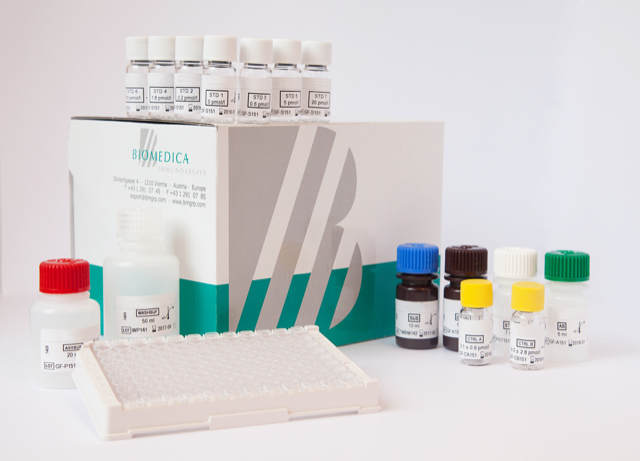Osteoprotegerin ELISA Assay Kit
Osteoprotegerin ELISA Assay Kit Developed and Manufactured in Austria by Biomedica
Size: 1×96 wells
Sensitivity: LOD: (0 pmol/l + 3 SD): 0.07 pmol/l; LLOQ: 0.08 pmol/l
Dynamic Range: 0 to 20 pmol/l
Incubation Time: 5.5 hours
Sample Type: Serum, plasma (EDTA, heparin, citrate)
Sample Size: 20 µL
Alternative Names: OPG ELISA, Human OPG ELISA, Human Osteoprotegerin ELISA
For Research Use Only
Controls Included
Unit conversion: 1 pg/ml = 0.05 pmol/l (MW: 19.9 kD)
Specificity: The ELISA recognizes human endogenous and recombinant OPG. The OPG ELISA detects monomeric and dimeric OPG as well as OPGRANKL complexes. The assay does not cross-react with rat or mouse samples.
Assay Principle
The Osteoprotegerin ELISA Assay Kit is a sandwich enzyme immunoassay for the determination of OPG in human serum and plasma samples. In a first step, assay buffer, standard/control/sample and detection antibody (biotinylated monoclonal mouse anti-human OPG) are pipetted into the wells of the microtiter strips, which are pre-coated with polyclonal goat anti-human OPG antibody. OPG present in the standard/control/sample binds to the pre-coated antibody in the well and forms a sandwich with the detection antibody. In the washing step all non-specific unbound material is removed. In a second step, the conjugate (streptavidin-HRP) is pipetted into the wells and reacts with the detection antibody. After another washing step, the substrate (TMB, tetramethylbenzidine) is pipetted into the wells. The enzyme-catalyzed color change of the substrate is directly proportional to the amount of OPG. This color change is detectable with a standard microtiter plate reader. A dose response curve of the absorbance (optical density, OD at 450 nm) vs. standard concentration is generated. The concentration of OPG in the sample is determined directly from the dose response curve.
Related Products
Sclerostin ELISA Assay Kit
Human Periostin ELISA Assay Kit
Human DKK-1 ELISA Assay Kit




